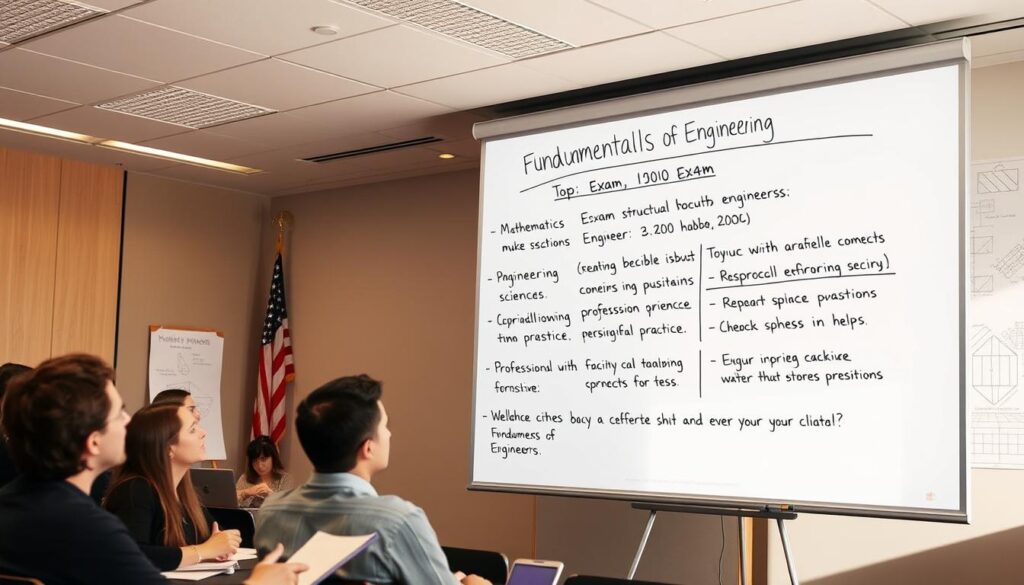Embarking on a career as a structural engineer can be a rewarding and challenging profession, requiring a deep understanding of engineering principles, mathematics, and science.
As the backbone of construction projects, structural engineers play a crucial role in ensuring the safety and durability of buildings and infrastructure. But what does it take to become a successful structural engineer in the USA?
The journey involves acquiring the right qualifications and following a well-defined career path. In this article, we will guide you through the essential steps to become a structural engineer, providing insights into the necessary education, skills, and certifications.
Key Takeaways
- Understand the basic qualifications required for a structural engineer.
- Learn about the educational pathways available.
- Discover the importance of certifications and licenses.
- Explore the key skills necessary for success.
- Gain insights into the career progression and growth opportunities.
Understanding Structural Engineering
Structural engineers play a vital role in shaping the built environment by designing and analyzing structures to withstand different types of loads. Their work is crucial in ensuring the safety and durability of buildings, bridges, and other infrastructure.
What is Structural Engineering?
Structural engineering is a specialized field within civil engineering that focuses on the design, construction, and analysis of structures. It involves understanding the behavior of structures under various loads, such as weight, wind, and seismic activity. Structural engineers use their knowledge of physics, mathematics, and materials science to create safe and efficient designs.
Key Responsibilities of Structural Engineers
The key responsibilities of structural engineers include:
- Designing and analyzing structures to ensure they can withstand various loads and stresses.
- Collaborating with architects, contractors, and other stakeholders to ensure that structures are built according to specifications.
- Conducting site visits to inspect structures and identify potential issues.
- Developing and implementing repair and maintenance plans for existing structures.
To illustrate the scope of their responsibilities, consider the following table that outlines the typical tasks and skills required for structural engineers:
| Task | Skills Required |
|---|---|
| Designing structures | Knowledge of structural analysis software, understanding of building codes |
| Analyzing structural integrity | Understanding of physics and materials science, analytical skills |
| Collaborating with stakeholders | Communication skills, project management abilities |
By understanding the role and responsibilities of structural engineers, individuals can better appreciate the importance of this field in creating safe and durable infrastructure. Pursuing a structural engineering career path requires a strong foundation in education requirements for structural engineers, including a relevant degree and professional licensure.
Educational Requirements for Structural Engineers
A career in structural engineering necessitates a thorough understanding of mathematical and physical principles, acquired through a structured educational journey. To become a structural engineer, one must start with a strong foundation in high school and continue through to a bachelor’s degree in a relevant field.
Necessary High School Subjects
High school students aspiring to become structural engineers should focus on subjects that build a strong foundation in mathematics and science. Key subjects include:
- Mathematics: Calculus, geometry, and algebra
- Physics: Understanding the principles of mechanics and energy
- Chemistry: Basic understanding of chemical principles
Excelling in these subjects will prepare students for the challenges of a structural engineering program in college.
Bachelor’s Degree Programs
A bachelor’s degree in civil engineering, structural engineering, or a related field is essential for becoming a structural engineer. These programs typically cover a wide range of topics, including:
- Structural analysis and design
- Mechanics of materials
- Geotechnical engineering
- Construction management
According to the American Society of Civil Engineers (ASCE), accreditation by the Engineering Accreditation Commission of ABET is crucial for ensuring that a program meets the necessary standards.
Accreditation Importance
Accreditation is a critical factor when selecting a bachelor’s degree program for structural engineering. It ensures that the program adheres to the standards set by the profession, preparing students for the Fundamentals of Engineering (FE) exam and eventually for licensure as a Professional Engineer (PE).
“Accreditation is a key step in ensuring that engineering programs produce graduates who are well-prepared to enter the workforce.” –
The importance of accreditation can be seen in the curriculum and the opportunities available to students. Here is a comparison of accredited vs. non-accredited programs:
| Program Aspect | Accredited Programs | Non-Accredited Programs |
|---|---|---|
| Curriculum | Comprehensive, includes practical experience | May lack specific courses or practical training |
| Licensure Preparation | Prepares students for FE exam | May not adequately prepare for FE exam |
| Job Prospects | Better job opportunities, higher starting salaries | Limited job opportunities |

In conclusion, becoming a structural engineer requires a well-planned educational pathway that includes the right high school subjects, a bachelor’s degree from an accredited program, and an understanding of the importance of accreditation. By following these steps, aspiring structural engineers can set themselves up for success in their future careers.
Choosing the Right College or University
For those aiming to become structural engineers, the choice of college or university is crucial. This decision lays the foundation for their future career, influencing the quality of education they receive and the opportunities available to them.
Top Schools for Structural Engineering
Several institutions in the United States are renowned for their structural engineering programs. These schools offer comprehensive curricula, cutting-edge research opportunities, and strong industry connections.
- Massachusetts Institute of Technology (MIT)
- Stanford University
- University of California, Berkeley
- Georgia Institute of Technology
- University of Illinois at Urbana-Champaign
These universities are recognized for producing well-rounded graduates who are prepared to tackle the challenges of the structural engineering field.
Factors to Consider When Selecting a School
When choosing a college or university for structural engineering, several factors should be considered to ensure the best fit for one’s career aspirations.
| Factor | Description | Importance |
|---|---|---|
| Accreditation | Ensure the program is accredited by a recognized accrediting agency, such as ABET. | High |
| Curriculum | Look for a comprehensive curriculum that covers both theoretical foundations and practical applications. | High |
| Faculty Expertise | Consider the qualifications and research interests of the faculty members. | Medium |
| Internship Opportunities | Check if the school offers internships or co-op programs that provide real-world experience. | High |
By carefully evaluating these factors, prospective students can make an informed decision that aligns with their steps to become a structural engineer and meets their structural engineer qualifications.
Gaining Relevant Experience
The path to a successful career in structural engineering is paved with relevant experience. As an aspiring structural engineer, it’s crucial to understand that theoretical knowledge is just the starting point. Practical experience helps in applying theoretical concepts to real-world problems, developing problem-solving skills, and building a professional network.
Internships During College
Internships during college are an excellent way to gain hands-on experience in the field of structural engineering. These programs allow students to work with experienced engineers, participate in real projects, and understand the day-to-day responsibilities of a structural engineer.
Benefits of Internships:
- Practical experience in designing and analyzing structures
- Opportunity to work with various software and technologies used in the industry
- Networking opportunities with professionals in the field
- Enhanced job prospects upon graduation
Co-op Programs
Co-op programs are another valuable way for students to gain relevant experience. These programs typically involve alternating periods of academic study and paid, relevant work experience.
Key Features of Co-op Programs:
- Paid work experience related to structural engineering
- Opportunities to apply theoretical knowledge in practical settings
- Development of professional skills and networking
Entry-Level Positions
Upon graduation, securing an entry-level position is a significant step towards gaining relevant experience. These positions are designed for recent graduates and provide a structured environment to learn and grow.
| Type of Experience | Description | Benefits |
|---|---|---|
| Internships | Short-term work experience during college | Practical skills, industry connections |
| Co-op Programs | Alternating periods of study and paid work | Comprehensive industry understanding, paid experience |
| Entry-Level Positions | First job after graduation, supervised work | Professional growth, structured learning |
Gaining relevant experience is a multifaceted approach that includes internships, co-op programs, and entry-level positions. Each of these opportunities plays a vital role in shaping a successful career in structural engineering.

Importance of Professional Licensure
Professional licensure is not just a formality; it’s a critical component of a structural engineer’s career, signifying expertise and commitment to the field. In the United States, the process of becoming a licensed structural engineer is rigorous and multifaceted, reflecting the profession’s high standards.
What is a PE License?
A Professional Engineer (PE) license is a certification that validates a structural engineer’s qualifications and competence. It’s earned after passing the Principles and Practice of Engineering (PE) exam, which is administered by the National Council of Examiners for Engineering and Surveying (NCEES).
The PE license is significant because it:
- Signifies that the engineer has met specific educational and experience requirements.
- Demonstrates expertise in applying engineering principles and practices.
- Is often required for senior roles or for signing off on projects.
Steps to Obtain Your License
Becoming a licensed structural engineer involves several steps:
- Earn a bachelor’s degree from an Accreditation Board for Engineering and Technology (ABET)-accredited program.
- Pass the Fundamentals of Engineering (FE) exam to become an Engineer-in-Training (EIT) or Engineering Intern (EI).
- Gain relevant work experience under the supervision of a licensed PE.
- Pass the Principles and Practice of Engineering (PE) exam to become a licensed PE.
Maintaining licensure typically requires continuing education to stay updated with industry developments and best practices.
The importance of professional licensure cannot be overstated. It’s a mark of excellence that distinguishes experienced, qualified engineers from others in the field. For structural engineers aiming to advance their careers, obtaining a PE license is a crucial step.
Preparing for the Fundamentals of Engineering Exam
Passing the Fundamentals of Engineering exam is a crucial milestone for aspiring structural engineers, marking the beginning of their professional journey. This exam is the first step towards obtaining a Professional Engineer (PE) license, which is essential for advancing in the field of structural engineering.
Overview of the Exam Structure
The Fundamentals of Engineering (FE) exam is designed to test the knowledge and skills of engineering graduates and those nearing graduation. The exam is typically taken during the last year of college or shortly after graduation. It covers a broad range of topics related to engineering fundamentals, including mathematics, physics, and engineering principles.
The FE exam is usually computer-based and consists of multiple-choice questions. The exam format may vary depending on the specific discipline, such as civil engineering, which is most relevant to structural engineers. It’s essential to familiarize yourself with the exam format and content to prepare effectively.

Study Resources and Tips
Effective preparation is key to passing the FE exam. Here are some study resources and tips to help you prepare:
- Review Course Materials: Utilize review courses and study materials specifically designed for the FE exam. These resources often include practice problems and detailed explanations of key concepts.
- Practice Exams: Take practice exams to assess your knowledge and identify areas where you need to focus your studying.
- Study Groups: Joining a study group can be beneficial, as it allows you to collaborate with others who are also preparing for the exam.
- Time Management: Develop a study plan and stick to it. Effective time management is crucial to cover all the necessary material.
By understanding the exam structure and utilizing the right study resources, you can increase your chances of passing the Fundamentals of Engineering exam and taking the next step towards becoming a licensed structural engineer.
Advancing Through Experience
Experience plays a vital role in shaping the career of a structural engineer. As they progress in their profession, the accumulation of work experience and continuous learning become essential for career advancement.
Importance of Work Experience
Gaining substantial work experience is crucial for structural engineers. It not only enhances their technical skills but also develops their problem-solving abilities and judgment. Hands-on experience allows them to apply theoretical knowledge in real-world scenarios, making them more competent professionals.
Work experience also opens up opportunities for structural engineers to specialize in specific areas, such as seismic design or bridge construction. This specialization can lead to greater expertise and recognition within the industry.
Seeking Professional Development Opportunities
Professional development is vital for structural engineers to stay updated with the latest technologies, codes, and best practices. Continuing education is not just a requirement for maintaining licensure but also a necessity for career progression.
Structural engineers can seek professional development through various means, such as attending workshops, seminars, and conferences. These events provide opportunities to learn from industry experts and network with peers. Additionally, participating in professional associations can offer access to resources, training, and updates on industry trends.
By combining work experience with continuous professional development, structural engineers can significantly enhance their career prospects. This proactive approach to their profession not only benefits their personal growth but also contributes to the advancement of the structural engineering field as a whole.
Networking in the Industry
Networking plays a vital role in the career of a structural engineer, providing access to valuable resources and connections. Effective networking can lead to new opportunities, collaborations, and a deeper understanding of industry trends.
Joining Professional Associations
One of the most effective ways to network is by joining professional associations related to structural engineering. These organizations offer numerous benefits, including:
- Access to exclusive events and conferences
- Opportunities to connect with experienced professionals
- Updates on the latest industry standards and technologies
- Professional development resources, such as workshops and webinars
Some notable professional associations for structural engineers in the USA include the American Society of Civil Engineers (ASCE) and the Structural Engineering Institute (SEI). Membership in these organizations can significantly enhance a structural engineer’s career by providing networking opportunities, professional development, and access to industry resources.

Attending Conferences and Workshops
Attending conferences and workshops is another crucial aspect of networking in the structural engineering industry. These events provide a platform for professionals to share knowledge, discuss challenges, and explore new technologies. Some benefits of attending these events include:
- Learning about the latest advancements and innovations
- Meeting and collaborating with other professionals
- Presenting your work and receiving feedback
- Staying updated on industry best practices and standards
By actively participating in conferences and workshops, structural engineers can expand their professional network, enhance their knowledge, and stay competitive in the industry.
Understanding Structural Engineering Specialties
Structural engineering is a diverse field with numerous specialties, each presenting unique challenges and opportunities. To become a successful structural engineer, one must understand the various fields within this discipline and the requirements for specializing in them.
Structural engineering encompasses a broad spectrum of specialties, including but not limited to, building design, bridge construction, and seismic design. Each of these areas requires a deep understanding of structural engineering principles and often, specialized knowledge.
Types of Structural Engineering Fields
Some of the key fields within structural engineering include:
- Building Design: Focuses on the structural integrity of buildings, ensuring they can withstand various loads and stresses.
- Bridge Construction: Involves designing and maintaining bridges, requiring an understanding of dynamic loads and environmental factors.
- Seismic Design: Concerned with designing structures that can resist earthquake forces, a critical specialty in seismically active regions.
To excel in these fields, structural engineers must meet specific structural engineering degree requirements, which typically include a bachelor’s degree in civil or structural engineering from an accredited program.
| Specialty | Description | Key Skills |
|---|---|---|
| Building Design | Designing safe and durable buildings | Knowledge of building codes, structural analysis |
| Bridge Construction | Designing and maintaining bridges | Understanding of dynamic loads, material science |
| Seismic Design | Designing structures to resist earthquakes | Knowledge of seismic analysis, ductility design |
Emerging Areas in the Field
The field of structural engineering is continually evolving, with emerging areas such as sustainable design and resilient infrastructure gaining prominence. These areas not only require traditional structural engineering knowledge but also an understanding of sustainability principles and resilience strategies.
As infrastructure needs grow and environmental concerns become more pressing, the demand for structural engineers with expertise in these emerging areas is likely to increase. Thus, aspiring structural engineers should consider gaining knowledge in these areas to stay relevant.
Becoming a licensed structural engineer involves not just meeting the educational requirements but also gaining practical experience and passing the Professional Engineer (PE) exam. Understanding the various specialties within structural engineering can help individuals tailor their education and career paths to their interests and the needs of the industry.
Software Proficiency for Structural Engineers
The use of advanced software has become a cornerstone in the practice of structural engineering, enabling engineers to model, analyze, and optimize their designs with precision. As the field continues to evolve, the importance of software proficiency cannot be overstated.
Structural engineers utilize a variety of software tools to perform their duties efficiently. These tools range from computer-aided design (CAD) software to complex finite element analysis (FEA) programs.
Common Software Used
Some of the most commonly used software in structural engineering includes:
- Autodesk Revit
- Autodesk AutoCAD
- STAAD
- ETABS
- SAP2000
These software tools are essential for creating detailed designs, analyzing structural integrity, and ensuring compliance with building codes and regulations.
| Software | Primary Use | Industry Recognition |
|---|---|---|
| Autodesk Revit | Building Information Modeling (BIM) | High |
| STAAD | Structural Analysis | High |
| ETABS | Structural Analysis and Design | High |
Importance of Staying Updated with Technology
Staying updated with the latest software and technological advancements is crucial for structural engineers. This not only enhances their ability to design and analyze structures but also improves their competitiveness in the job market.
Continuous learning and professional development are key to maintaining software proficiency. This can be achieved through:
- Participating in software training programs
- Attending industry conferences and workshops
- Engaging with online forums and communities

By embracing new technologies and software, structural engineers can improve their practice, enhance project outcomes, and contribute to the advancement of the field.
Soft Skills for Structural Engineers
While technical skills form the backbone of a structural engineer’s qualifications, soft skills play a crucial role in determining their success in the field. Structural engineers must be adept at communicating complex ideas and collaborating with various stakeholders, including architects, contractors, and clients.
Communication Skills
Effective communication is vital for structural engineers, as it ensures that project specifications are clearly understood and implemented. This involves not only verbal communication but also the ability to prepare clear, concise reports and drawings.
Key aspects of communication skills include:
- Articulating design intent and structural solutions
- Coordinating with project teams to address challenges
- Presenting findings and recommendations to clients
Problem-Solving Abilities
Structural engineers frequently encounter complex problems that require innovative solutions. Their ability to analyze situations, identify potential issues, and develop effective solutions is critical to project success.
Effective problem-solving involves:
- Analyzing data to identify structural issues
- Developing and evaluating potential solutions
- Implementing the most appropriate solution
| Soft Skill | Description | Importance in Structural Engineering |
|---|---|---|
| Communication | Ability to convey ideas and plans clearly | High – Ensures project understanding and collaboration |
| Problem-Solving | Capacity to analyze and resolve complex issues | High – Critical for project success and safety |
Keeping Up with Industry Trends
To remain competitive, structural engineers must keep abreast of industry trends and advancements. The field is constantly evolving, with new technologies and methodologies being introduced regularly.
Continuous Learning and Education
Continuous learning is essential for structural engineers to stay updated with the latest developments. This can be achieved through various means, including:
- Attending workshops and conferences
- Participating in online courses and webinars
- Pursuing advanced degrees or certifications
As Leonard Joseph, a renowned structural engineer, once said, “The moment you stop learning is the moment you become obsolete.” This quote underscores the importance of ongoing education in maintaining a successful career in structural engineering.
“The moment you stop learning is the moment you become obsolete.”
Following Major Industry Publications
Staying informed about industry trends also involves following major publications. Some key resources include:
| Publication | Description | Frequency |
|---|---|---|
| Structural Engineer Magazine | Covers news, projects, and trends in structural engineering | Monthly |
| ASCE Journal of Structural Engineering | Publishes research and case studies on structural engineering topics | Quarterly |
| Engineering News-Record (ENR) | Provides news and analysis on the construction and engineering industries | Weekly |
By engaging with these publications, structural engineers can gain insights into the latest developments and network with other professionals in the field.

Moreover, leveraging social media and professional networks can further enhance one’s ability to stay current. Following industry leaders and participating in online forums can provide additional insights and opportunities for growth.
Exploring Career Paths in Structural Engineering
The field of structural engineering encompasses a broad spectrum of career options, from design and analysis to management and consultancy. With a strong foundation in structural engineering degree requirements, professionals can navigate various paths that suit their interests and skills.
Diverse Job Opportunities
Structural engineers can explore a variety of roles, including:
- Design Engineer: Focuses on designing structures using software and technical knowledge.
- Analysis Engineer: Conducts structural analysis to ensure safety and compliance.
- Project Manager: Oversees projects from conception to completion, ensuring timely and within-budget delivery.
- Consultant: Provides expert advice on structural integrity and feasibility.
These roles require a deep understanding of structural principles and often involve collaboration with other professionals in the field.
| Job Title | Primary Responsibilities | Required Skills |
|---|---|---|
| Design Engineer | Designing structures, creating models | Proficiency in CAD software, understanding of structural mechanics |
| Analysis Engineer | Conducting structural analysis, ensuring compliance | Knowledge of analysis software, attention to detail |
| Project Manager | Overseeing projects, managing timelines and budgets | Leadership skills, project management tools, communication |
Roles Beyond Engineering
Beyond traditional engineering roles, structural engineers can transition into:
- Teaching and Research: Sharing knowledge and advancing the field through education and research.
- Policy Making: Influencing industry standards and regulations.
- Entrepreneurship: Starting their own consultancy or firm.
The structural engineer licensing process often provides a foundation for these diverse career paths, as it demonstrates a level of expertise and commitment to the profession.
Salary Expectations and Job Outlook
For those looking to become structural engineers, knowing the average salary and future job prospects is essential. This knowledge helps in making informed decisions about one’s career path.

Average Salary for Structural Engineers
The average salary for structural engineers in the United States varies based on factors like location, experience, and industry. According to the Bureau of Labor Statistics, the median annual salary for civil engineers, which includes structural engineers, was $87,060 in May 2020. Entry-level positions typically start around $60,000, while experienced engineers can earn upwards of $120,000 or more per year. Factors such as working in metropolitan areas or for prominent construction companies can further influence salary scales.
Future Job Growth Projections
The job outlook for structural engineers is generally positive, driven by the need for infrastructure development and renovation. The Bureau of Labor Statistics projects that employment of civil engineers, including structural engineers, will grow 2% from 2020 to 2030. This growth is slower than the average for all occupations, but it still represents a steady demand for skilled professionals in this field. As the U.S. continues to invest in infrastructure projects, the demand for structural engineers is expected to remain strong, particularly in regions undergoing significant development.
To succeed in this field, it’s crucial to follow the steps to become a structural engineer, including obtaining the necessary education, gaining relevant experience, and obtaining professional licensure. By doing so, individuals can position themselves for a rewarding career with competitive salary expectations and a positive job outlook.
Tips for a Successful Career
A successful career in structural engineering is built on a combination of technical expertise and strategic professional growth. As the field continues to evolve, staying ahead of the curve requires a proactive approach to career development.
Building a Strong Professional Portfolio
A strong professional portfolio is essential for demonstrating your capabilities to potential employers. It should include a variety of projects that showcase your skills in structural analysis, design, and problem-solving. Including projects that highlight your proficiency in relevant software and technologies can significantly enhance your portfolio.
When curating your portfolio, consider the following:
- Highlighting complex projects that demonstrate your technical skills
- Including feedback or testimonials from supervisors or clients
- Showcasing your role in team projects and your contributions to their success
According to
“The key to a successful career is to be proactive and continually seek opportunities for growth and development.” –
This mindset is crucial for building a strong professional portfolio.
Finding Mentorship Opportunities
Finding a mentor who is experienced in structural engineering can provide valuable guidance and support. Mentors can offer insights into industry best practices, help navigate career challenges, and provide recommendations for professional development. Seeking out mentors through professional associations or industry events can be particularly effective.
To maximize the benefits of mentorship, consider:
- Identifying potential mentors who have experience in your desired career path
- Preparing thoughtful questions and topics for discussion
- Following up with your mentor to continue the relationship over time
By focusing on building a strong professional portfolio and seeking out mentorship opportunities, you can significantly enhance your career prospects in structural engineering. Obtaining structural engineering certification can also be a valuable credential, demonstrating your expertise and commitment to the field.
Resources for Aspiring Structural Engineers
Aspiring structural engineers can benefit greatly from a variety of resources that aid in their educational and professional journey. These resources range from educational materials to professional networks that provide support and guidance.
Recommended Books and Websites
Several books and websites are highly recommended for those looking to become structural engineers. “Structural Engineering: A Very Short Introduction” by David Blockley is a great starting point, offering insights into the field. Websites like the American Society of Civil Engineers (ASCE) provide valuable information on the latest developments and standards in structural engineering.
Other useful resources include online courses and tutorials on platforms like Coursera and edX, which offer a range of structural engineering courses from reputable universities. 
Educational Organizations and Support
Joining professional organizations can be highly beneficial for aspiring structural engineers. The Structural Engineering Institute (SEI) is one such organization that provides members with access to the latest research, networking opportunities, and professional development resources.
Additionally, many local and national engineering societies offer support through mentorship programs, workshops, and conferences. These organizations play a crucial role in helping individuals meet the education requirements for structural engineers and guide them through the process of becoming a licensed structural engineer.
Conclusion: Starting Your Journey as a Structural Engineer
Embarking on a career as a structural engineer in the USA is a rewarding journey that requires dedication, hard work, and a commitment to lifelong learning. By understanding the educational requirements, gaining relevant experience, and obtaining professional licensure, you can set yourself up for success in this field.
Career Initiation Steps
To start your career, focus on building a strong foundation in structural engineering principles, and stay updated with industry trends and technologies. Joining professional associations and networking with experienced engineers can also provide valuable insights and opportunities. As you begin your structural engineering career path, remember that continuous learning and professional development are key to advancing in this field.
With the right mindset and preparation, you can navigate the process of how to become a structural engineer in the USA and achieve your career goals. Take the first step today by exploring educational programs, seeking out internships, and connecting with professionals in the industry.
